Eagles rebuild at White Rock Lake after nest crashes
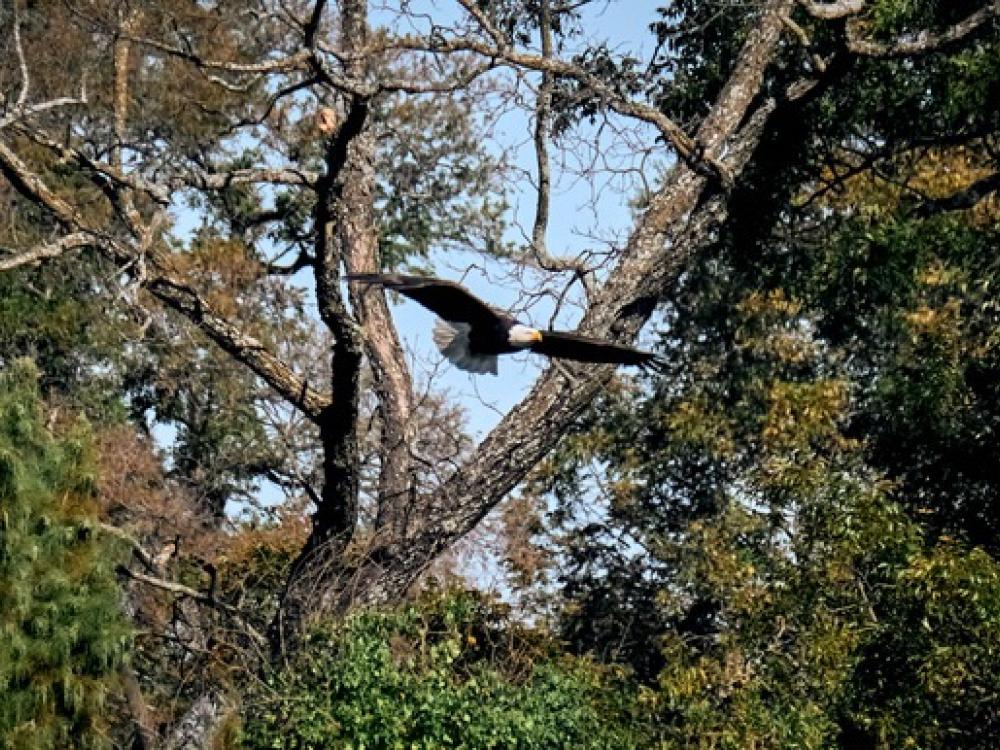
A bald eagle swoops through trees at White Rock Lake. A nesting pair at the lake recently made headlines. Photo by Adam Velte.
Birdwatchers noticed the pair of young bald eagles at White Rock Lake last October.
They reported it to Brett Johnson, environmental biologist for Dallas Parks and Recreation Department, who alerted wildlife biologists from Texas Parks and Wildlife and U.S. Fish and Wildlife Service to the urban sighting.
Bald eagles had been occasional visitors to the lake for years, but these eagles — dubbed Nick and Nora from the old Thin Man detective films — were seen almost daily.
A favorite haunt was the lake’s east side where Dixon Branch enters between Winfrey Point and the old Dreyfus Club site.
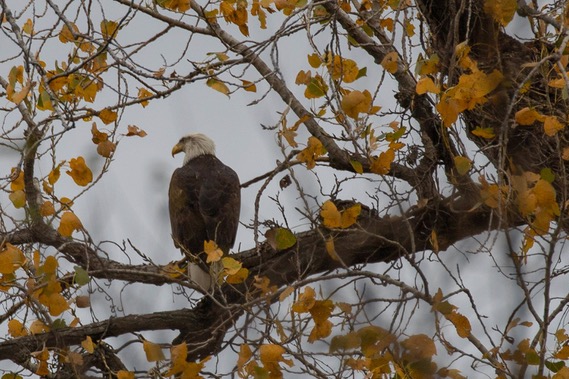
“That’s the shallow area on Sunset Bay where people like feeding the waterfowl. We don’t encourage it,” said Johnson. “For situations like this, it does create easy pickings. The eagles have been taking small ones like coots and such.”
The floating food bits also attract fish, eagles’ favorite food, and the shallow water makes snatching them a breeze. But fish are plentiful throughout the lake.
Imagine, a pair of bald eagles choosing White Rock Lake, a small reservoir within 10 minutes of downtown Dallas!
But it makes sense.
Plentiful large trees, good water quality, no jarring powerboats and abundant fish and waterfowl, plus development pushed back from shore — all make it undoubtedly attractive. It’s a testament to the work of Dallas Park and Rec arborists and biologists who are doing an admirable job of managing the lake for wildlife.
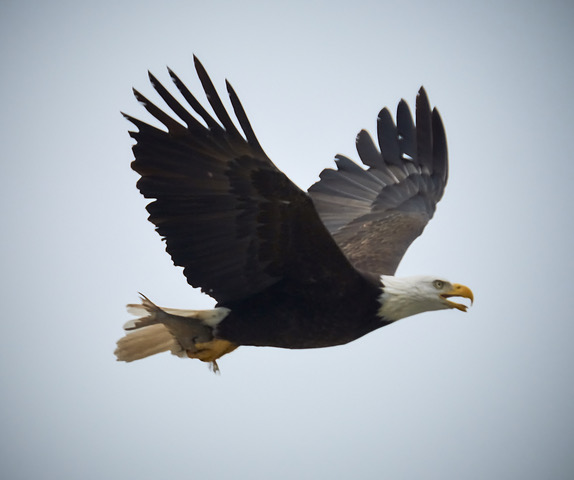
ROMANCE AT THE LAKE
Soon eagle-eyed birdwatchers noticed the pair flying along the Dixon Branch corridor to Lake Highlands Park, a large sports park at Buckner and Lake Highlands. They often headed with sticks in their beaks toward an abandoned hawk’s nest in an old cottonwood — sure indications of nesting behavior.
Birdwatchers and wildlife professionals were flummoxed.
While bald eagles will feed in the presence of people, they typically prefer secluded locations for nests. This pair chose woods on the edge of a popular rugby and soccer field, just 800 feet off busy six-lane Buckner Boulevard.
“The eagles are nesting in quite possibly the worst known location,” said Johnson. “We hoped the activity level of the area would encourage them to move along, but they’re looking at that easy commute to Sunset Bay.”
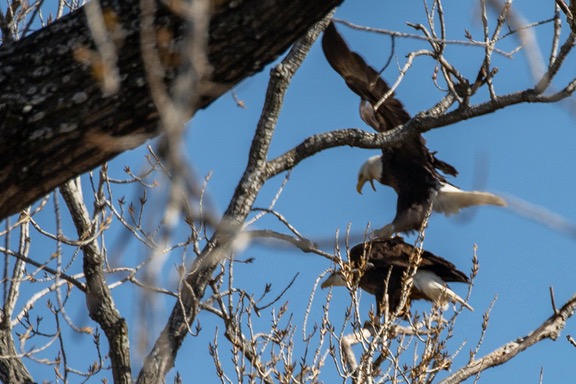
Nick and Nora in the act of mating. Photo by Grady Hinton.
“The eagles are nesting in quite possibly the worst known location,” said Johnson. “We hoped the activity level of the area would encourage them to move along, but they’re looking at that easy commute to Sunset Bay.”
In February, photographers and birdwatchers sighted Nick and Nora mating. Bald eagles copulate multiple times over a few days to ensure fertilization. The eagles, estimated by Johnson to be around four years old, were going to be first-time parents. Egg incubation takes about five weeks.
DO NOT DISTURB
As soon as nesting behavior was evident, Johnson and associates went to work making the area around the nest adhere to the Bald and Golden Eagle Protection Act, which forbids disturbance or harassment of the eagles. Fines range from $5000 to $250,000, depending on if it’s a repeat offense, multiple offenses or done by an organization or business. USFWS offers rewards if information on violations leads to arrest and conviction.
The team had fencing erected to keep people 330 feet from the nest as prescribed by the act. Johnson reported that the eagles were visibly agitated by humans, and especially dogs, near the tree base.

“We had to go to a bigger, heavier fence,” said Johnson. “Even once we had the construction fence and signs up, people, especially those walking their dogs, weren’t paying attention.”
Even more disturbing to the eagles, he said, were people allowing their dogs to roam unleashed on the field, contrary to park regulations.
“It presents a lot of challenges for sure,” said Johnson.
Nor is it wise to disturb these immense birds. Bald eagles aggressively defend their territory during nesting periods, chasing out other raptors, vultures and birds like crows. They’ll attack foxes, coyotes, bobcats and dogs as well as humans — whatever is near their nest. An eagle’s two-inch, razor-sharp talons can quickly inflict severe damage.
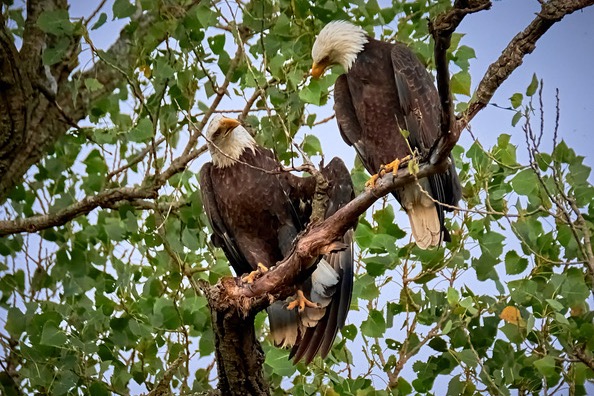
Eagle watchers have reported on social media multiple instances of drones, presumably with cameras, buzzing the nest.
“A drone would be a very significant disturbance. A clear violation of the Bald Eagle Act and subject to its fines,” said Johnson.
TRAGIC TWIST
The nest continued to grow, perilously perched atop a dead limb. According to Johnson, one and sometimes both eagles were at the nest near constantly by early February. Then the female stayed on the nest almost continually for days.
But on a blustery afternoon on Feb. 15, the unthinkable happened. Fifteen to 30 mph winds took the nest down.
“To say it shattered is an understatement. Keep in mind, it was a really dry stick nest that fell from 50 feet up,” said Johnson.
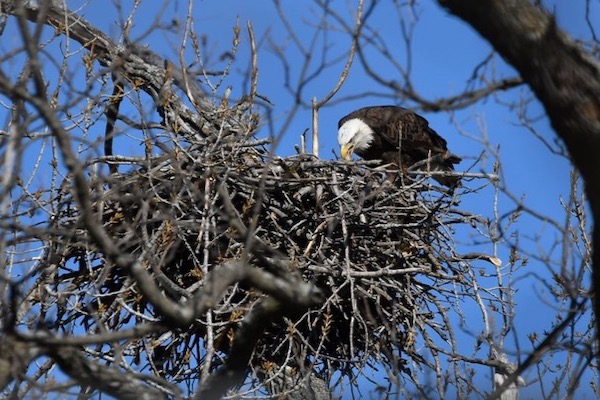
Sadly, the remains of one to three eggs were among the nest debris.
The USFWS biologist, TPWD game warden, Dallas Parks and Recreation park ranger and Johnson rapidly converged on the scene.
“Due to legal technicalities, the game warden took possession of everything related to the nest,” said Johnson.
LEARNING FROM LOSS
Word of the incident flashed through social media. Soon dozens were on hand to witness the heartbreaking spectacle of Nick and Nora circling above the area, reacting to the loss.
“Most of that evening and all day for the next few days, the young eagles were flying around, calling out to each other a lot,” said Sam Kieschnick, TPWD urban biologist for DFW. “Much crying from both the eagles and the public!”
The eagles are definitely “first timers” when it comes to nests, said Kieschnick. The dead limb beneath the nest could support the weight of the hawk nest they repurposed, but not the added weight when the eagles enlarged it, he observed.
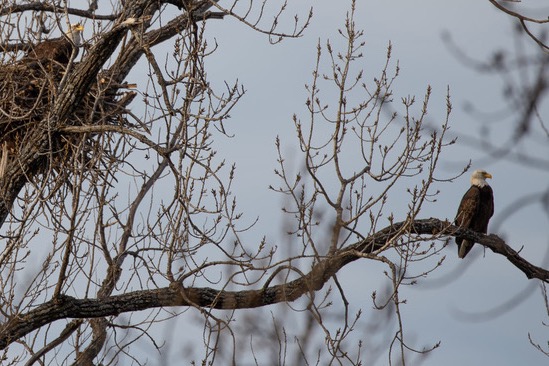
“This is how an eagle couple learns what works and what doesn’t. That location definitely didn’t work,” said Kieschnick. “They usually pair for life, returning to the same nest, so they’ll grow from this experience. And that’s a great thing.”
Kieschnick said the pair seem to be repurposing another hawk nest further into the park.
“It may be a bit late for another clutch of eggs, but we’ll continue to monitor it,” he said.
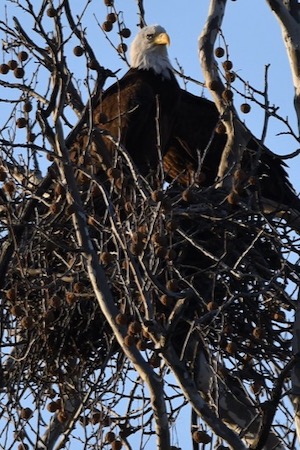
But Johnson is skeptical.
“I would not get real excited about their rebuilding effort,” cautioned Johnson. “The side limbs holding the new nest are fine, but the main limb directly under it is greying out, showing signs of being dead or dying. But the tree itself is a much more viable tree than the cottonwood was. Even so, don’t get too attached.”
A BIT ABOUT BALD EAGLES
Bald eagles’ enormous wings move with solid and graceful beats. They hold their wings horizontal when soaring, casting an immense shadow that strikes fear into potential prey. Juvenile bald eagles retain dark heads and mottled brown and white coloring for up to five years. Adults and juveniles can fly hundreds of miles a day.
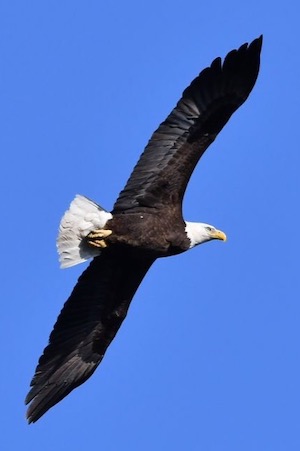
Bald eagles’ talons are two inches long and can grip with a force of up to 1,000 pounds per square inch. They’re designed to swiftly snatch and kill large fish like carp swimming beneath the surface, or to pluck prey away from other predators, something that eagles do enthusiastically.
Its hooked bill can crush the neck of avian prey in an instant. But the curved bill is also useful for another favored food activity: scavenging. It can tear into even large carcasses like deer.
“They don’t have the most dignified diet in the world: roadkill, dead fish floating around in the lake and the like,” said Johnson.
Bald eagles, as well as other raptors, are adjusting to urban environments. A bald eagle dubbed Rover makes regular visits to Central Park’s reservoir in New York City, thrilling visitors as it feasts on gulls and other birds. Rover frequently visits Brooklyn and other boroughs in the densely populated area.

“There’s a bald eagle that likes to hang out in the middle of downtown Tulsa,” said Johnson.
THE COMEBACK BIRD
Though bald eagles have served as the United States national emblem since 1782, hunting, trapping or poisoning them was legal. Populations plummeted in the 1900s as development and agriculture increased.
The Bald Eagle Protection Act was enacted in 1940, forbidding harassing or killing the bird and making possession of any body part or nest a federal crime. Golden eagles were added later.
By 1950, things looked good for bald eagles. Then the use of pesticides, especially DDT, became widespread. As apex predators at the end of the food chain, pesticides accumulate in eagle bodies, causing eggshells to be so thin they crush during laying or incubation.
Populations plummeted. In 1963, there were only 487 nesting pairs in the nation. In 1972, DDT was banned by the federal government. By 1978, bald eagles were listed for protection under the Endangered Species Act.
Intelligent and resilient birds, bald eagles gained enough in numbers within 20 years to regain their widespread range through much of the continent. By 2007, the species no longer warranted endangered species protection. Now there are over 71,400 breeding pairs in the U.S.

But now, the trend is reversing. When eagles scavenge hunter-killed animal carcasses, they consume rifle and shotgun ammunition containing lead. A large study published in the Feb.17, 2022 edition of the journal Science stated that almost 50 percent of bald eagles have chronic lead poisoning and around 30 percent suffer from acute poisoning — enough to hinder population growth by nearly four percent.
When eagles scavenge hunter-killed animal carcasses, they consume rifle and shotgun ammunition containing lead. A large study published in the Feb.17, 2022 edition of the journal Science stated that almost 50 percent of bald eagles have chronic lead poisoning and around 30 percent suffer from acute poisoning.
Like most wildlife, bald eagles struggle to survive habitat loss. Their territory is wide, from a few square miles where food is flush to 15 square miles where it’s not. They prefer to be around large bodies of water. Bald eagles need large and tall trees for nests — an increasingly rare commodity, especially around developed rivers and lakes. All greatly limit suitable nesting sites.
PART TWO: WHERE TO SEE BALD EAGLES IN NORTH TEXAS
 A sign at White Rock Lake warns visitors to adhere to federal protections of the bald eagle. Photo by Amy Martin.
A sign at White Rock Lake warns visitors to adhere to federal protections of the bald eagle. Photo by Amy Martin.
Learn the best places to see eagles at White Rock Lake and other North Texas locations in this detailed guide.
RELATED ARTICLES
Where to see eagles in North Texas
Backyard feeders may provide hunting ground for hawks
Stay up to date on everything green in North Texas, including the latest news and events! Sign up for the weekly Green Source DFW Newsletter! Follow us on Facebook and Twitter. Also check out our new podcast The Texas Green Report, available on your favorite podcast app.





